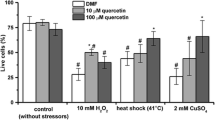Abstract
The effects of C7-alkylhydroxybenzene (С7-AHB) and p-hydroxyethylphenol (tyrosol), chemical analogs of microbial anabiosis autoregulators, on the viability of yeast cells under oxidative stress were investigated. The stress was caused by reactive oxygen species (ROS) produced under γ irradiation of cell suspensions using doses of 10–150 krad at an intensity of 194 rad/s or by singlet oxygen generated in cells photosensitized with chlorin e 6 (10 μg/l). C7-AHB was found to exert a protective effect. The addition of 0.05–0.16 vol % of C7-AHB to cell suspensions 30 min before irradiation protected yeast cells from γ radiation (50 krad). The protective effect of C7-AHB manifested itself both in the preservation of cell viability during irradiation and in the recovery of their capacity to proliferate after irradiation. In our studies on photodynamic cell inactivation, the fact that the phenolic antioxidant C7-AHB protects cells from intracellular singlet oxygen was revealed for the first time. The analysis of difference absorption spectra of oxidized derivatives of C7-AHB demonstrated that the protective mechanism of С7-AHB involves the scavenging of ROS resulting from oxidative stress. The fact that tyrosol failed to perform a photoprotective function suggests that the antioxidant properties of microbial С7-AHB are not related to its chaperon functions. The results obtained make an important addition to the spectrum of known antioxidant and antistress effects of phenolic compounds.
Similar content being viewed by others
REFERENCES
Sies, H., Oxidative Stress—from Basic Research to Clinical Application, Amer. J. Med., 1991, vol. 91,suppl. 3C, pp. S31-S38.
Roginskii, V.A., Fenol'nye antioksidanty. Reaktsionnaya sposobnost' i effektivnost' (Phenolic Antioxidants: Reactivity and Effectiveness), Moscow: Nauka, 1988.
Osipov, G.A., El'-Registan, G.I., Svetlichnyi, V.A., Kozlova, A.N., Duda, V.I., Kaprel'yants, A.S., and Pomazanov, V.V., On the Chemical Nature of the d1 Autoregulatory Factor of Pseudomonas carboxydoflava, Mikrobiologiya, 1985, vol. 54,no. 2, pp. 184–190.
Batrakov, S.G., El'-Registan, G.I., Pridachina, N.N., Nenasheva, V.A., Kozlova, A.N., Gryaznova, M.N., and Zolotareva, I.N., Tyrosol Is the d1 Autoregulatory Factor of Saccharomyces cerevisiae, Mikrobiologiya, 1993, vol. 62,no. 4, pp. 633–638.
Mulyukin, A.L., Lusta, K.A., Gryaznova, M.N., Kozlova, A.N., Duzha, M.V., Duda, V.I., and El'-Registan, G.I., Formation of Resting Cells by Bacillus cereus and Micrococcus luteus, Mikrobiologiya, 1996, vol. 65,no. 6, pp. 782–789.
Kaprel'yants, A.S., El'-Registan, G.I., Suleimenov, M.K., Sorokina, A.D., Deborin, G.A., Stoyanovich, F.M., Lille, Yu.E., and Ostrovskii, D.N., Structural-Functional Changes in Model Bacterial Membranes under the Action of Phenolic Lipids, Biol. Membr., 1987, vol. 4, pp. 254–261.
Kolpakov, A.I., Il'inskaya, O.N., Bespalov, M.M., Kupriyanova-Ashina, F.G., Gal'chenko, V.F., Kurganov, B.I., and El'-Registan, G.I., Stabilization of Enzymes by Dormancy Autoinducers as a Possible Mechanism of Resistance of Resting Microbial Forms, Mikrobiologiya, 2000, vol. 69,no. 2, pp. 224–230.
Bespalov, M.M., Kolpakov, A.I., Loiko, N.G., Doroshenko, E.V., Mulyukin, A.L., Varlamova, E.A., Kurganov, B.I., and El'-Registan, G.I., The Role of Microbial Dormancy Autoinducers in Metabolism Blockade, Mikrobiologiya, 2000, vol. 69,no. 2, pp. 217–223.
Vostroknutova, G.A., Kaprel'yants, A.S., El'-Registan, G.I., Skrypin, V.I., Kozlova, A.N., Ostrovskii, D.N., and Duda, V.I., Alterations in the Structure of Micrococcus lysodeikticus Membranes under the Action of Preparations of the d1 Bacterial Autoregulatory Factors, Prikl. Biokhim. Mikrobiol., 1985, vol. 21,no. 3, pp. 378–381.
Strakhovskaya, M.G., Shumarina, A.O., Ivanova, E.V., and Fraikin, G.Ya., Involvement of Endogenous Porphyrins in the Inactivation of Candida guilliermondii by Visible Light, Mikrobiologiya, 1998, vol. 67, pp. 360–363.
Van der Meulen, F.W., Ibrahim, K., Sterenborg, H.J., Alphen, L.V., Maikoe, A., and Dankert, J., Photodynamic Destruction of Haemophilus parainfluenzae by Endogenously Produced Porphyrins, J. Photochem. Photobiol. B, 1997, vol. 40, pp. 204–208.
Peng, Q., Berg, K., Moan, J., Kongshaug, M., and Nesland, J.M., 5-Aminolevulinic Acid-Based Photodynamic Therapy: Principles and Experimental Research, Photochem. Photobiol., 1997, vol. 65, pp. 235–251.
Biological Aspects of Aging and Deceleration of Aging by Antioxidants, Itogi Nauki Tekh., Ser. Obshch. Probl. Biol., Burlakova, E.B. and Nadzharyan, T.L., Eds., Moscow: VINITI, 1986, pp. 1–240.
Musso, H., Phenol Oxidation Reactions, Ange. Chem. Int. Edit., 1963, vol. 2,no. 12, pp. 723–735.
Tonami, H., Uyama, H., Kobayashi, S., Fujita, T., Taguchi, Y., and Osada, K., Chemoselective Oxidative Polymerization of m-Ethynylphenol by Peroxidase Catalyst to a New Reactive Polyphenol, Biomacromolecules, 2000, vol. 2,no. 1, pp. 149–151.
Kozubek, A. and Tyman, J.H.P., Resorcinolic Lipids, the Natural Non-Isoprenoid Phenolic Amphiphiles and Their Biological Activity, Chem. Rev., 1999, vol. 99,no. 1, pp. 1–31.
Welch, W.J. and Brown, C.R., Influence of Molecular and Chemical Chaperones on Protein Folding, Cell Stress. Chaperones, 1996, vol. 1,no. 2, pp. 109–115.
Revina, A.A., Stepanenko, I.Yu., Kochetova, M.V., Larionov, M.V., Lutsik, T.K., Karpekina, T.A., Boudrant, J., and El-Registan, G.I., Radioprotection of Trypsin by Alkylhydroxybenzenes, Abstr. 3rd Int. Conf. on Protein Stabilization: Biocatalyst Stability, Different Level of Observation, Toulouse, 21–24 April, 2002, p. 68.
Nonhebel, D. and Walton, J., Free-Radical Chemistry: Structure and Mechanism, Cambridge: Cambridge Univ., 1974, p. 606.
Author information
Authors and Affiliations
Rights and permissions
About this article
Cite this article
Stepanenko, I.Y., Strakhovskaya, M.G., Belenikina, N.S. et al. Protection of Saccharomyces cerevisiae against Oxidative and Radiation-Caused Damage by Alkylhydroxybenzenes. Microbiology 73, 163–169 (2004). https://doi.org/10.1023/B:MICI.0000023984.42794.21
Issue Date:
DOI: https://doi.org/10.1023/B:MICI.0000023984.42794.21




